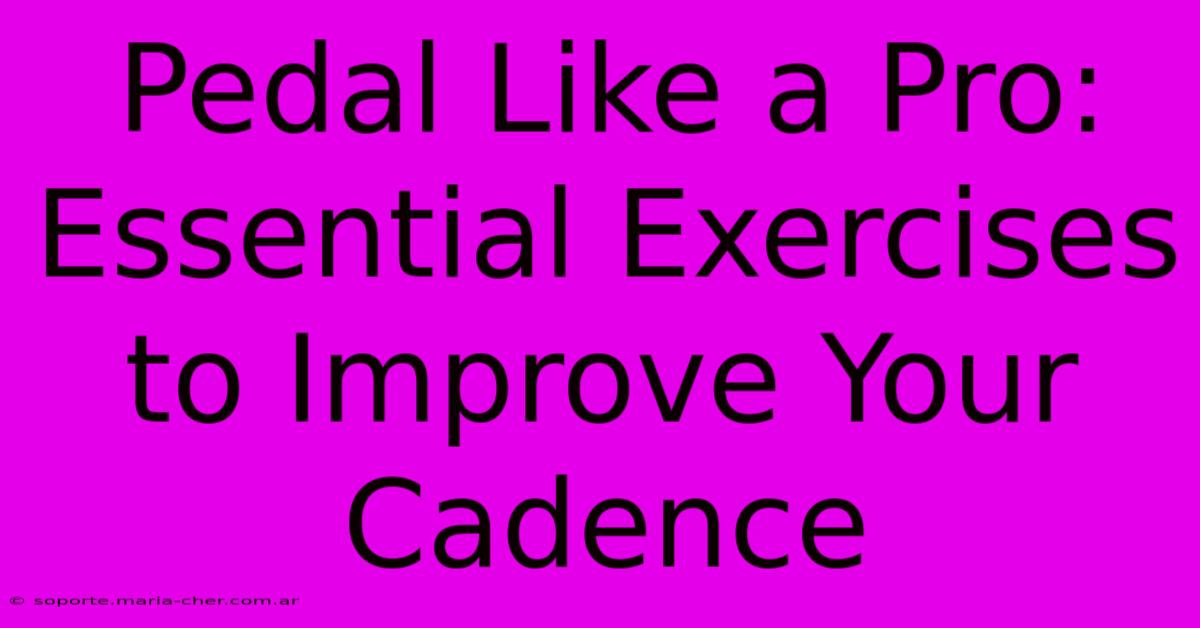Pedal Like A Pro: Essential Exercises To Improve Your Cadence

Table of Contents
Pedal Like a Pro: Essential Exercises to Improve Your Cadence
Are you ready to transform your cycling performance? Improving your cadence – the number of revolutions your pedals make per minute – is key to unlocking greater speed, efficiency, and endurance. A higher cadence means less strain on your legs, smoother power delivery, and ultimately, a more enjoyable ride. This comprehensive guide will explore essential exercises to boost your cadence and propel you to the next level.
Understanding the Importance of Cadence
Before diving into the exercises, let's understand why cadence is so crucial. Many cyclists fall into the trap of relying on brute force, grinding away with a low cadence and high torque. This puts excessive strain on your knees and quads, leading to fatigue and potential injury. A higher cadence, typically between 90-110 RPM (revolutions per minute), distributes the effort more evenly across your leg muscles, promoting smoother power transfer and increased efficiency. This translates to:
- Increased Speed and Power: Higher cadence allows you to maintain a higher speed with less effort.
- Improved Endurance: You'll fatigue less quickly, allowing for longer rides.
- Reduced Risk of Injury: Even power distribution minimizes strain on your joints.
- Better Muscle Development: You’ll engage a wider range of muscle groups.
Exercises to Elevate Your Cadence
Now, let's get to the practical aspect – the exercises. Remember consistency is key! Incorporate these into your training routine regularly for optimal results.
1. High Cadence Intervals: The Foundation
This is the cornerstone of cadence improvement. Find a flat road or use a stationary trainer. Perform intervals of high-cadence spinning. A good starting point is 5-10 minutes at 100-110 RPM, followed by a recovery period at a lower cadence. Gradually increase the duration and intensity of your high-cadence intervals as you get stronger. Remember to maintain a relatively light gear.
2. Cadence Drills on the Trainer: Precision Training
Stationary trainers offer a controlled environment for focused cadence work. Many trainers provide cadence displays, allowing you to monitor your RPM precisely. Try these drills:
- Target Cadence Drills: Set a specific cadence (e.g., 95 RPM) and maintain it for a sustained period.
- Cadence Pyramid Drills: Gradually increase your cadence over a set period, then gradually decrease it, creating a pyramid shape on your cadence graph.
- Cadence Jumps: Suddenly increase your cadence by 10-15 RPM for short bursts, then return to your base cadence.
3. Single-Leg Drills: Isolating Muscle Groups
This exercise helps you focus on each leg individually, improving leg strength and coordination. Perform high-cadence intervals, alternating between pedaling with just your right leg and then just your left. This improves your muscle balance and technique.
4. Out-of-Saddle Spinning: Power and Cadence
While not solely focused on cadence, out-of-saddle spinning, especially at higher cadences, engages different muscle groups and improves your overall power and efficiency. Short bursts of out-of-saddle high-cadence sprints can be very effective.
5. Strength Training: Building the Foundation
While focused on cycling, don't neglect overall strength training. Stronger legs will be able to maintain a higher cadence for longer periods. Include exercises such as squats, lunges, and deadlifts in your routine.
Monitoring Your Progress and Adapting Your Training
Tracking your progress is crucial. Use a cycling computer or app to monitor your cadence during your rides and training sessions. Note your improvement over time, and adjust your training plan accordingly. Listen to your body, and don't hesitate to adjust the intensity and duration of your exercises as needed.
Conclusion: Spin Your Way to Success
Improving your cadence is a journey, not a sprint. By consistently incorporating these exercises into your training plan, you'll significantly enhance your cycling performance. Remember to focus on proper technique, monitor your progress, and enjoy the ride! With dedication and the right approach, you'll soon be pedaling like a pro.

Thank you for visiting our website wich cover about Pedal Like A Pro: Essential Exercises To Improve Your Cadence. We hope the information provided has been useful to you. Feel free to contact us if you have any questions or need further assistance. See you next time and dont miss to bookmark.
Featured Posts
-
Unleash The Power Of Type Fonts That Speak Volumes In The Fashion World
Feb 08, 2025
-
Decoding The Celtic Knot Uncover The Intricate Meanings Woven Into Timeless Designs
Feb 08, 2025
-
Unlock The Secrets Of Different Portrait Types Which One Captures Your Soul
Feb 08, 2025
-
Trendsetters In Stripes The Intriguing Uniform Design That Makes Boise State Unforgettable
Feb 08, 2025
-
The Sabre Saber Enigma Slicing Through History And Semantics
Feb 08, 2025
